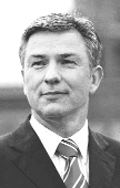Pioneer of gay liberation and the murder of gays in the Holocaust gaining greater attention
Thirty-six years separate the death of the modern German homosexual rights movement and the birth of modern gay liberation movement in America in 1969 on the streets of the West Village.
In 1933 the Nazis destroyed the most advanced and highly organized gay movement in the world. The Nazis’ first target was Magnus Hirschfeld, a German-Jewish physician who circulated a petition to abolish Germany’s anti-gay sodomy law, the infamous Paragraph 175. In support of his campaign to end discrimination against gays, Hirschfeld secured, among others, the signature of the closeted gay Nobel-prize winning author Thomas Mann.
The growing level of interest in Hirschfeld’s life in Germany and the effort to commemorate the gay victims of the National Socialists have culminated in a campaign, founded in 2005, called Initiative Queer Nations (www.initiative-queer-nations.de) to rebuild the world’s first research center devoted to sexology—the Institut für Sexualwissenschaft—which Hirschfeld founded in Berlin, 14 years before the Nazi backlash, in 1919.
The aim of the Initiative Queer Nations is to reestablish a research, historical, and memorial center at the site of Hirshfeld’s institute in Tiergarten in Berlin-Mitte. That effort has the support of Berlin’s gay mayor, Klaus Wowereit.
The Nazis viewed the combination of Hirschfeld’s Jewish identity and his research into gay, lesbian, bisexual, and transgender identity, expression, and political oppression as one of the most pressing threats to Nazi ideology. In the wake of the Nazi crackdown, Hirschfeld sought political refuge in France and died in exile in 1935. Hirschfeld’s political activism was matched by his scientific accomplishments.
Shortly after Hitler leveraged himself into power in 1933, the National Socialists destroyed Hirschfeld’s institute for sexual science and burned more than 10,000 volumes of research material, the most sophisticated collection of gay scientific literature at that time. Among the infamous pictures of book-burning in Nazi Germany are images from the destruction of Hirshfeld’s institute.
The leading gay journalist in Germany, Jan Feddersen, an editor with the progressive Germany daily, die taz, and a key initiator of the “queer nations” discussion in Germany, considers one of Hirschfeld’s great contributions to be his tireless efforts to collect empirical data on sexual diversity. The sexual scientist Alfred Kinsey relied on Hirschfeld’s questionnaire methodology to advance his research on American sexuality in the years after World War II. A journalist coined the phrase “The Einstein of Sex” to describe Hirschfeld’s stature within the field of sexology. That splashy headline was invoked following Hirschfeld’s meeting with Einstein in California in 1931. Hirschfeld’s issued a witty rejoinder that “Einstein is the Hirschfeld of Physics”.
The revival of interest in Hirschfeld has resulted in a wave of new publications in 2005 and 2006. Ralf Dose, the director of the Magnus Hirschfeld Society in Germany, wrote the new biography “Magnus Hirschfeld: German, Jew, and World Citizen.” The book is a tidy overview of Hirschfeld’s scientific accomplishments, his Jewishness, and his role within Germany society. The book has not yet been translated into English.
In 1930, Hirschfeld undertook a world tour to examine human sexuality and declared, “My field is the world and not only Germany and Europe”. The world trip encompassed Japan, China, the Philippines, Indonesia, and Singapore, Ceylon, India, Egypt, Palestine, and the U.S. His comparative analysis pointed to diversity across cultures—“There are not two lands and two populations with a complete match of sexual characteristics,” he wrote. The section of Hirschfeld’s world tour during the years 1931 and 1932 in the Middle-East and Asia were turned into a book reviewed in the March, 2006 issue of Literaturen, Das Journal für Bücher und Themen, one of Germany’s most prestigious publications, a kind of New York Review of Books.
Hirschfeld’s life in exile was the subject of a recent exhibition in Berlin covering the entries of more than 200 visitors in his guest book while he lived in France. The guest book is a “Who’s Who” of intellectual and cultural life of the early 1930s. Emma Goldman, the Greenwich Village anarchist, was a visitor as well as the French painter March Chagall. Hirschfeld’s life in exile was filled with intellectual exchanges and included a lecture at the Sorbonne, the elite French university. But, in a Parisian cinema he witnessed the weekly news program showing the Nazi destruction of his life’s work.

Hirschfeld’s writing crossed many different disciplines. He was a natural scientist who sought to prove that a biological basis for gayness existed. His deep preoccupation with cultural and sexual identity issues would make him, invoking today’s academic disciplines, a leading figure in the field of gender studies. Modern gender theorists, such as University of California at Berkeley philosopher and rhetoric professor Judith Butler, are descendents of his school of thought.
He died at the age of 67 and is buried in Nizza, a French city on the Mediterranean. The Latin motto on his gravestone “Per scientiam ad justitiam”—Through Science to Justice—reflects Hirschfeld’s political and scientific commitment to liberating sexual minorities from repressive political and cultural structures.
Curiously, the gay pride parades in German cities including Berlin, Hamburg, and Cologne do not bear the name of Germany’s most famous gay thinker and activist. Instead, the contemporary gay movement in Germany has adapted the name Christopher Street, modeled after the 1969 Stonewall riots, for its gay parades in June. Still, the New World gay struggle informs the history of the earlier Old World movement—the twin births of the gay liberation, in New York in 1969 and in Berlin before 1933, are intertwined in the pride celebrations.
The Initiative Queer Nations strives to highlight the importance of academic sexual research lacking in the popular view of gay liberation’s history. The group is also working to foster greater international academic cooperation. As a result, the institute Queer Nations plans a queer-oriented think tank which would advance the social scientific research of gays, lesbians, bisexuals, and transgendered people, as well heterosexuals. That effort would serve as a living memorial to the memories of persecuted German gays and lesbians.
More than 10,000 homosexuals were persecuted during the Hitler period, many of them murdered in extermination camps or castrated by the Nazis. The federal state of Berlin and the German federal government in January completed a competition for the design of a public sculpture to commemorate those victims of the Holocaust, a project funded with public money exceeding half a million dollars. The design by the Norwegian and Danish duo of gay artists, Michael Elmgreen and Ingar Dragset, presented this Tuesday at the Academy of the Arts in Berlin—a concrete cube in the shape of a house, with a black-and-white film picture of two men kissing—has drawn criticism for not including lesbian imagery.
The memorial will be situated across from the Holocaust memorial for the six million murdered Jews of Europe.
Benjamin Weinthal is a New York-born journalist who lives in Berlin.
gaycitynews.com



































